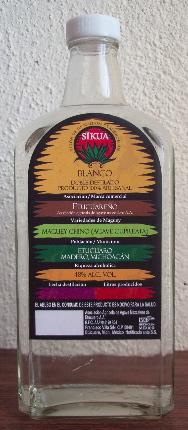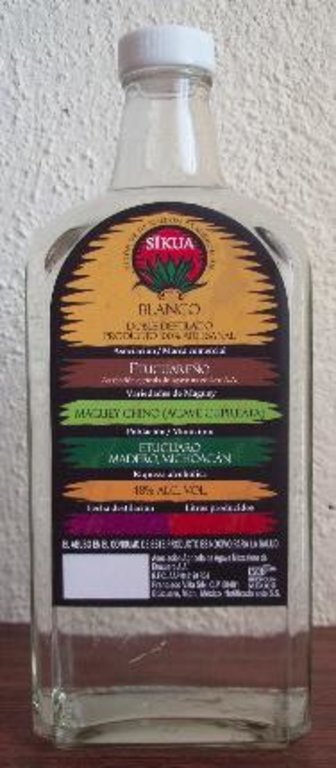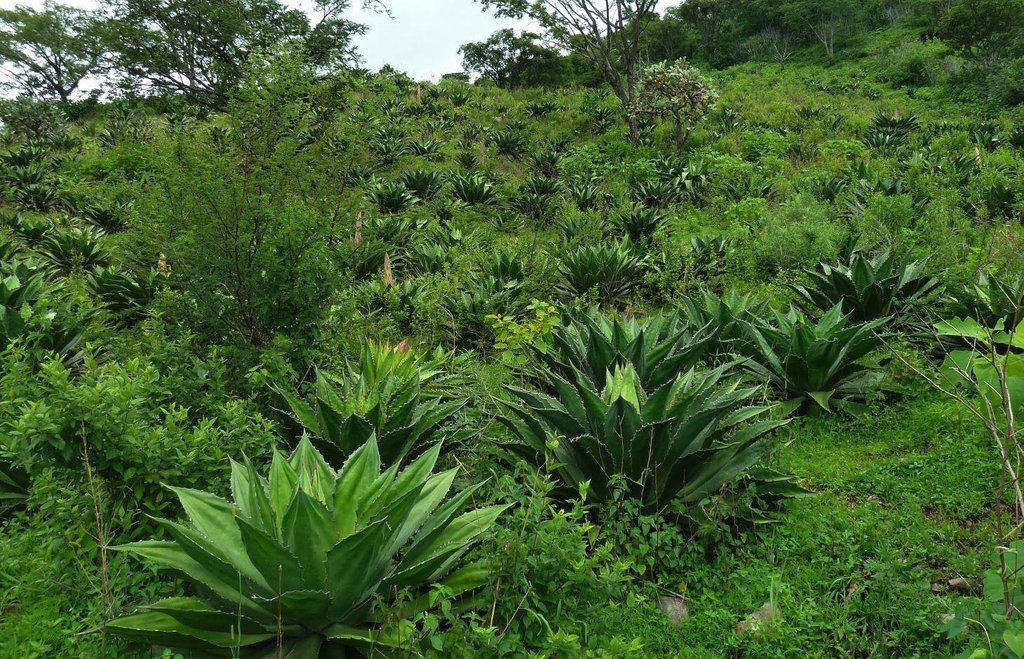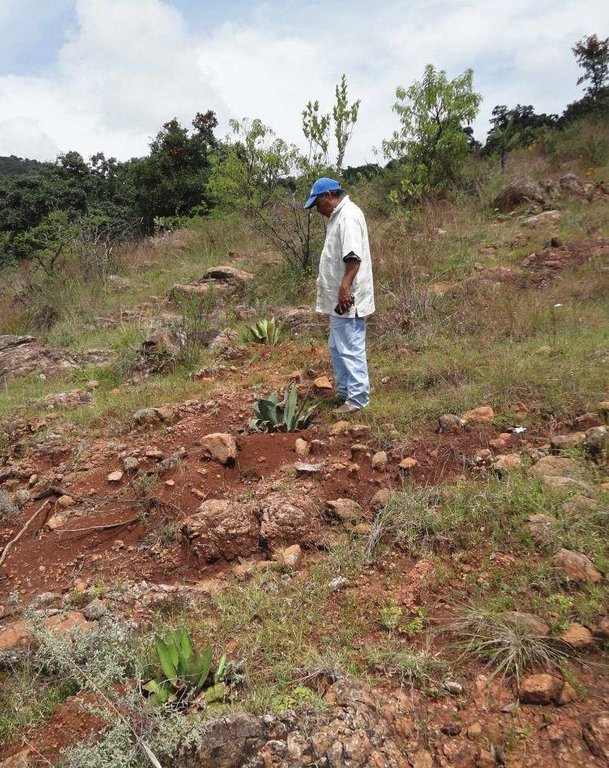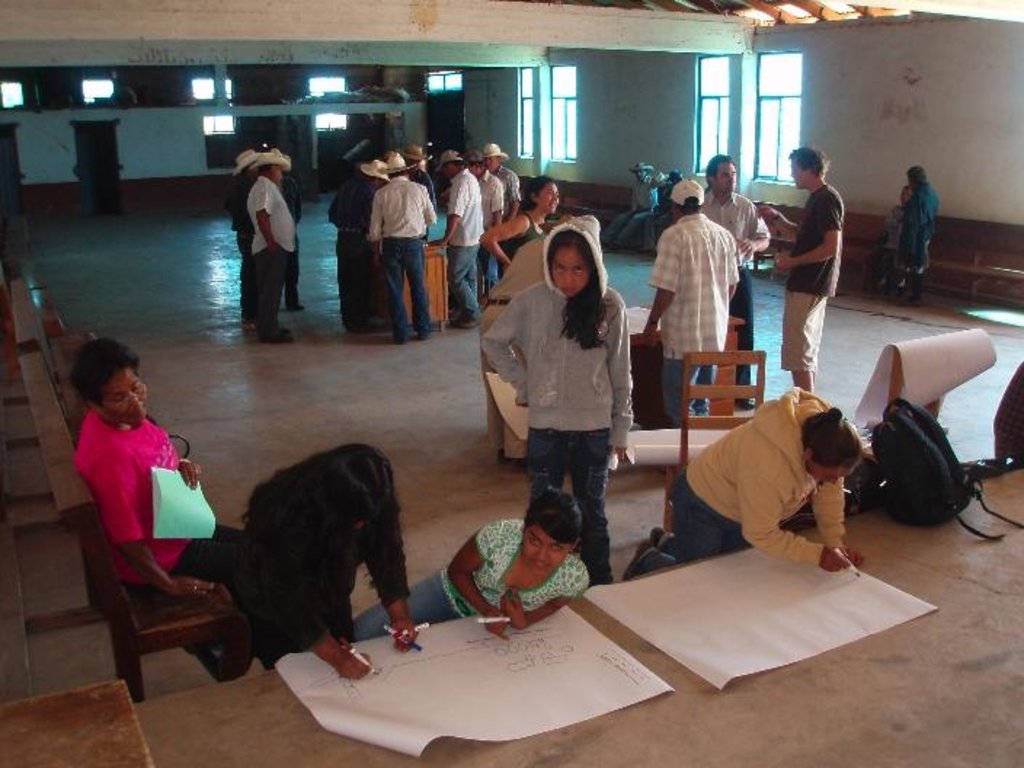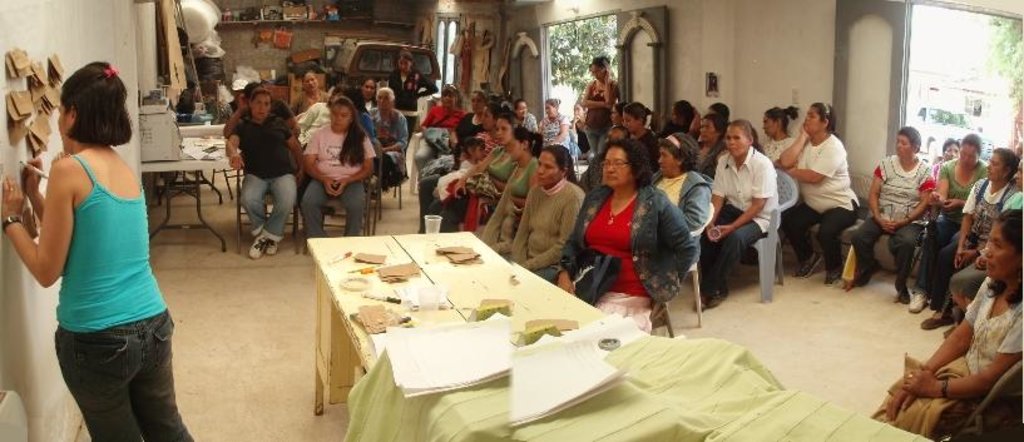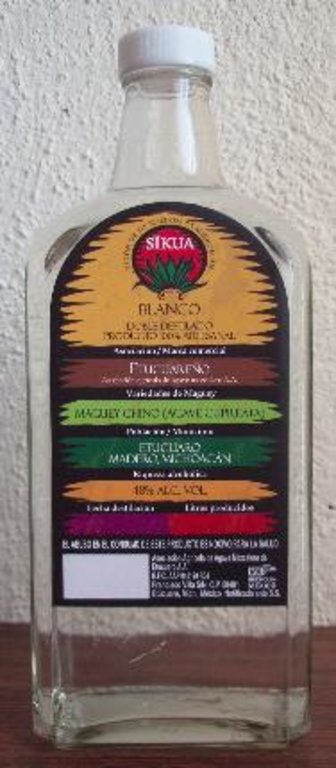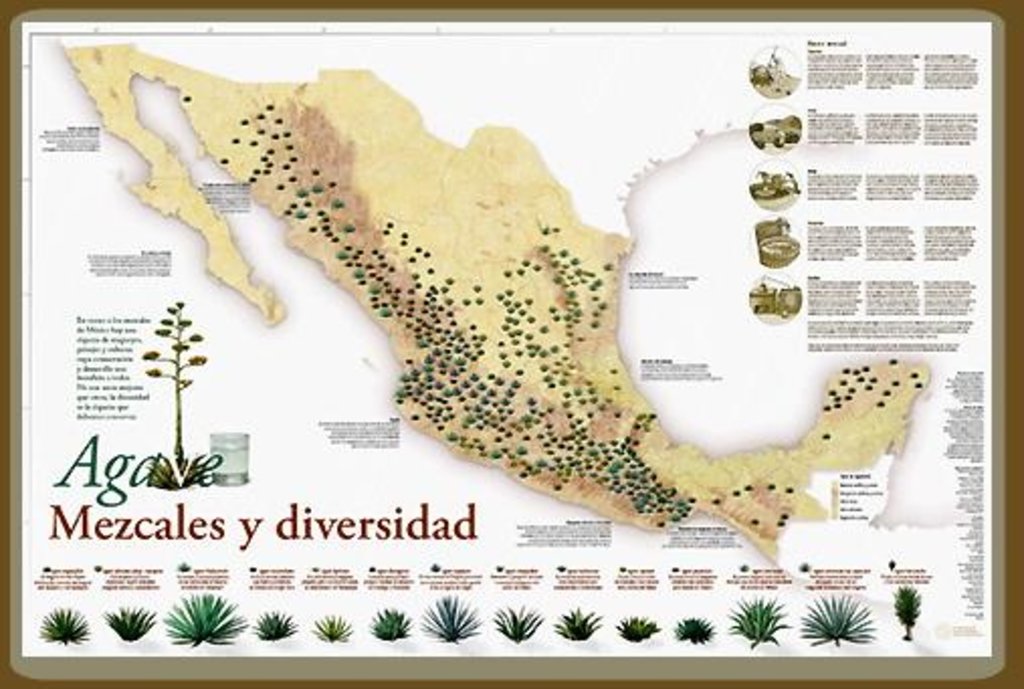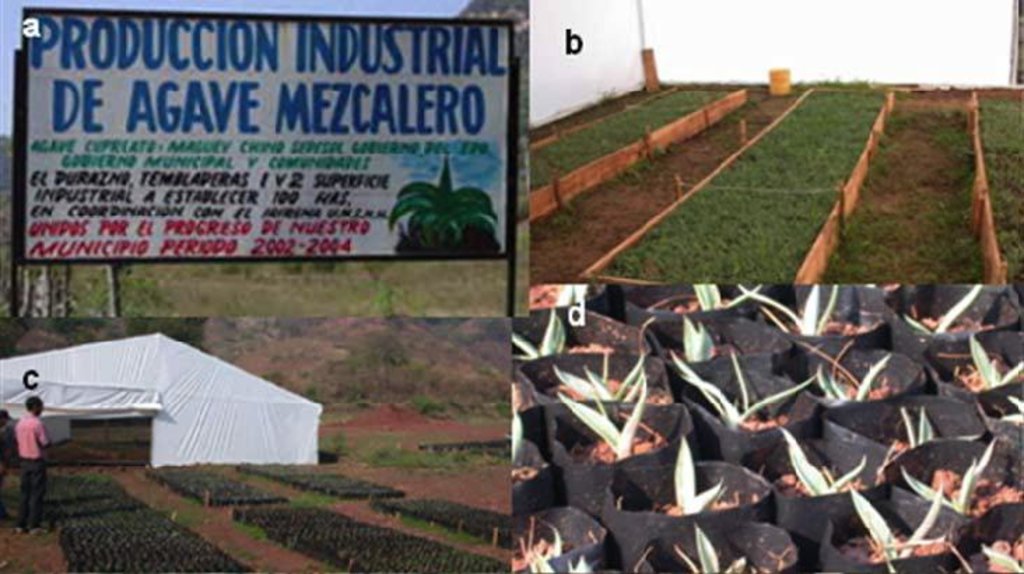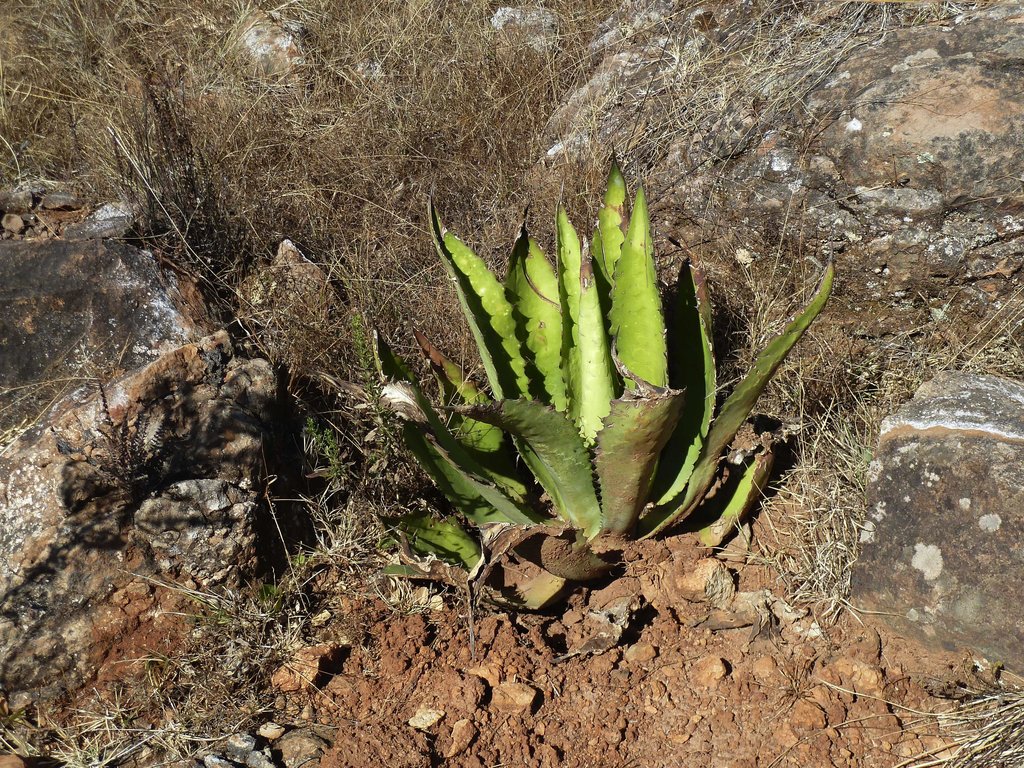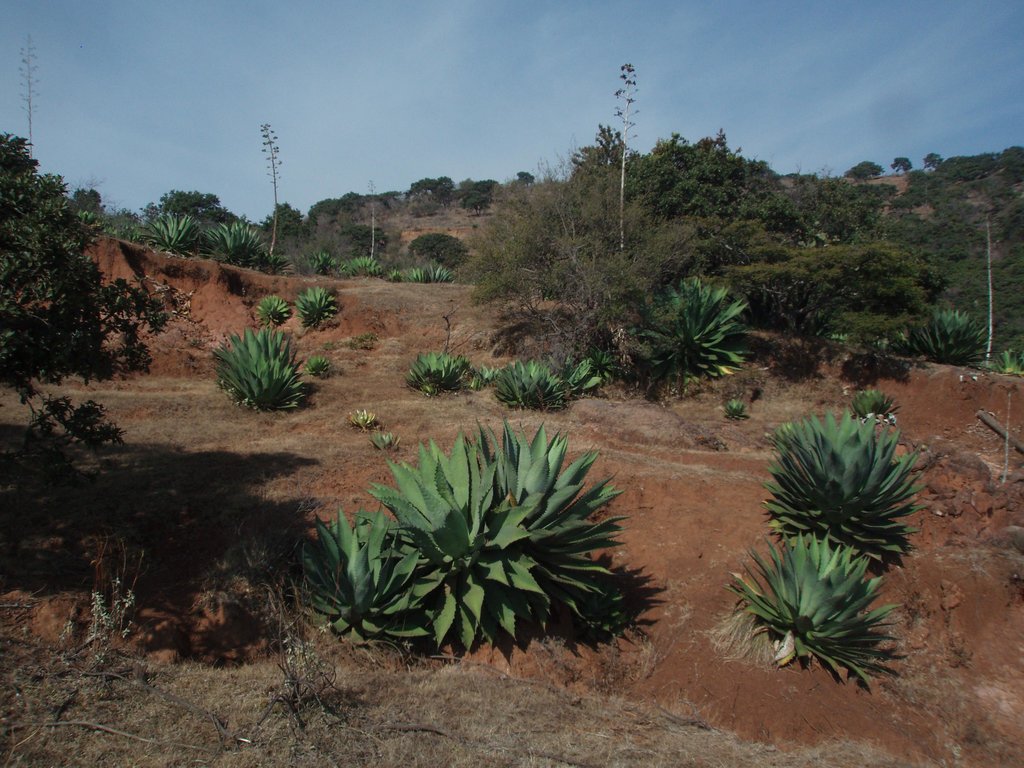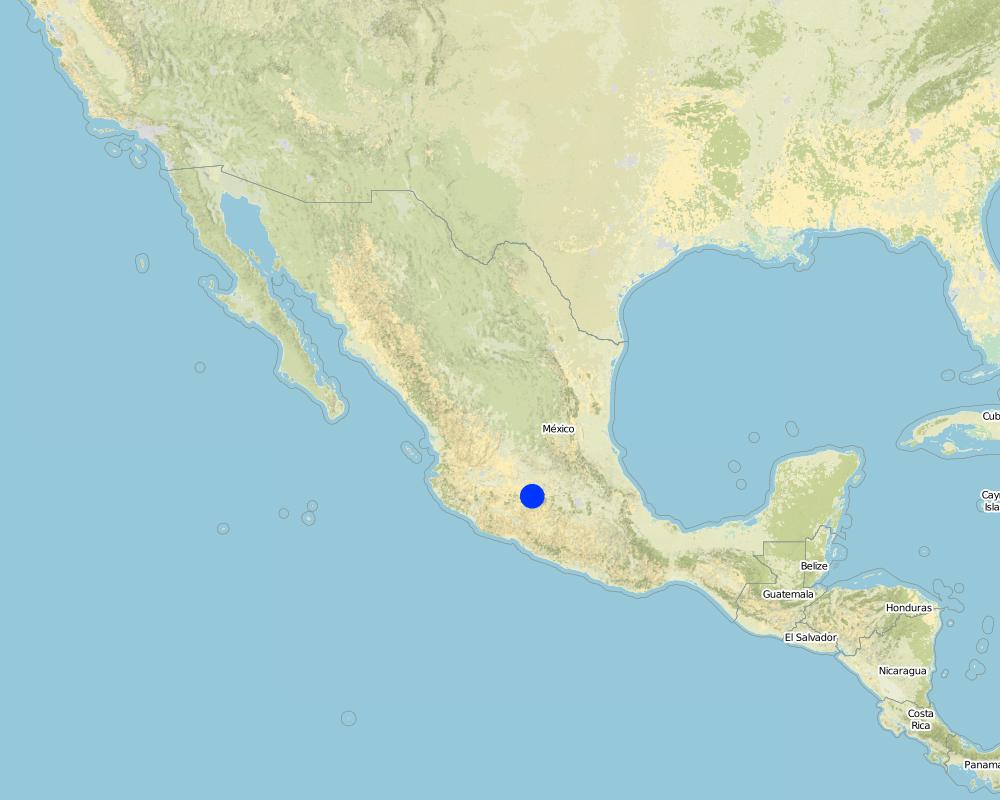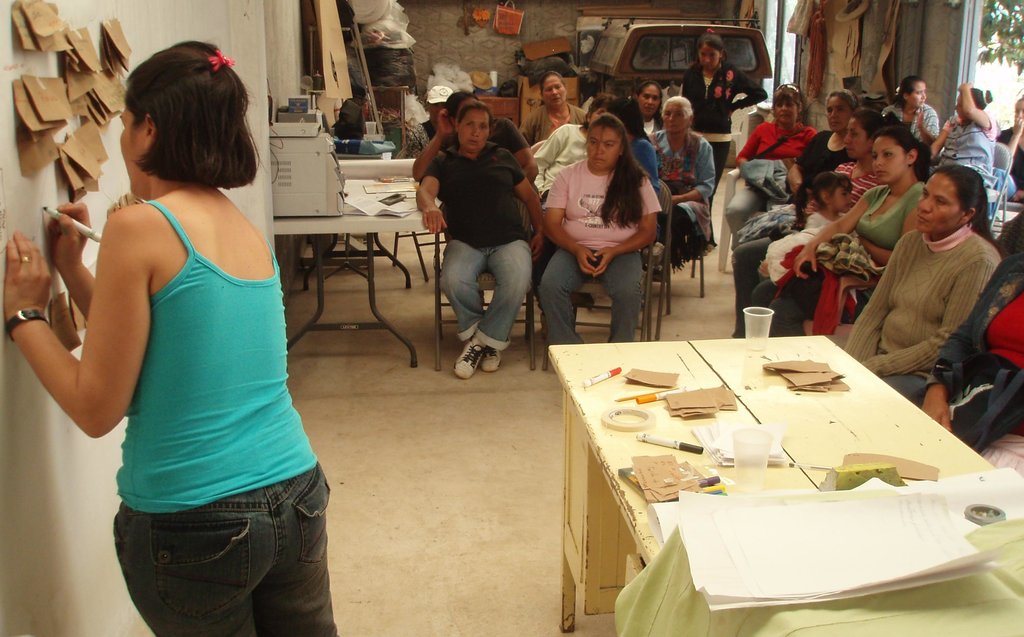Participative actions for economic benefits of agave forestry [เม็กซิโก]
- ผู้สร้างสรรค์:
- การอัพเดท:
- ผู้รวบรวม: Christian Prat
- ผู้เรียบเรียง: –
- ผู้ตรวจสอบ: Fabian Ottiger
Recuperación de tierras degradadas por agaveforestería a través de acciones participativas para beneficios económicos (Spanish)
approaches_2436 - เม็กซิโก
ดูส่วนย่อย
ขยายทั้งหมด ย่อทั้งหมด1. ข้อมูลทั่วไป
1.2 รายละเอียดที่ติดต่อได้ของผู้รวบรวมและองค์กรที่เกี่ยวข้องในการประเมินและการจัดเตรียมทำเอกสารของแนวทาง
ผู้เชี่ยวชาญ SLM:
Martínez Palacios Alejandro
Tel (443) 334-0475, Ext. 119
apalacios56@gmail.com
Instituto de Investigaciones Agropecuarias y Forestales, Universidad Michoacana de San Nicolás de Hidalgo (IIAF-UMSNH)
Morelia-Zinapecuaro, Tarímbaro, Michoacán 58330, México
เม็กซิโก
ผู้เชี่ยวชาญ SLM:
Ríos Patrón Eduardo
01 (443) 3226017
eduardo.rios@semarnat.gob.mx
Delegación de SEMARNAT (Secretaria del Medio Ambiente) en Michoacán, Unidad de Planeación y Política Ambienta
Morelia, Michoacán
เม็กซิโก
ชื่อของโครงการซึ่งอำนวยความสะดวกในการทำเอกสารหรือการประเมินแนวทาง (ถ้าเกี่ยวข้อง)
DESIRE (EU-DES!RE)ชื่อของโครงการซึ่งอำนวยความสะดวกในการทำเอกสารหรือการประเมินแนวทาง (ถ้าเกี่ยวข้อง)
Institut de recherche pour le développement IRD (Institut de recherche pour le développement IRD) - ฝรั่งเศสชื่อของโครงการซึ่งอำนวยความสะดวกในการทำเอกสารหรือการประเมินแนวทาง (ถ้าเกี่ยวข้อง)
Instituto de Investigaciones Agropecuarias y Forestales (IIAF) - เม็กซิโกชื่อของโครงการซึ่งอำนวยความสะดวกในการทำเอกสารหรือการประเมินแนวทาง (ถ้าเกี่ยวข้อง)
SECRETARÍA DE MEDIO AMBIENTE Y RECURSOS NATURALES (SECRETARÍA DE MEDIO AMBIENTE Y RECURSOS NATURALES) - เม็กซิโก1.3 เงื่อนไขที่เกี่ยวข้องกับการใช้ข้อมูลที่ได้บันทึกไว้ผ่านทาง WOCAT
ผู้รวบรวมและวิทยากรหลักยอมรับเงื่อนไขเกี่ยวกับการใช้ข้อมูลที่ถูกบันทึกผ่านทาง WOCAT:
ใช่
1.4 การอ้างอิงถึงแบบสอบถามเรื่องเทคโนโลยี SLM

Land reclamation by agave forestry with native species [เม็กซิโก]
Agave forestry land reclamation system with native agaves, trees, shrubs and grasses planted through participatory action for a sustainable production of mezcal and other products in order to generate high incomes for farmers.
- ผู้รวบรวม: Christian Prat
2. คำอธิบายของแนวทาง SLM
2.1 การอธิบายแบบสั้น ๆ ของแนวทาง
Land reclamation with local agave (to produce Mezcal) associated with trees, shrubs and grasses planted through participative actions for economic benefit.
2.2 การอธิบายอย่างละเอียดของแนวทาง
การอธิบายอย่างละเอียดของแนวทาง:
Aims / objectives: Rehabilitation of degraded land is achieved by using native agave (Agave inaequidens) and trees, shrubs and grasses which creates, over the medium-term (7-10 year), a sustainable production of an alcoholic drink (mezcal) and/or pharmaceutical products and/or fodder for cattle and/or wood. Further objectives are water conservation, biodiversity, generation of permanent employment (plant reproduction, planting, alcoholic drink/ pharmaceutical production), carbon sequestration, generation of higher family incomes and a reduction in the amount of livestock and number of animals and uncontrolled grazing (the main cause of soil erosion). These positive impacts of the approach contribute to preventing the rural population from emigrating to the cities or abroad.
Methods: Coordination, cooperation and systematic participatory process among stakeholders are the basis of the approach. Promoting participatory processes occurs through workshops, interviews with community leaders, field visits conducted with owners of the land to recognize the problems and identify areas of opportunity, training courses, exchange of experiences with other people who are developing similar projects at different stages. Technical advice and the links with scientists, technicians and public officials in charge of project beneficiaries is given under a two-way process of mutual learning and seeking to strengthen self-management capabilities that inspires innovation at the different stages. The key to success of a participatory approach lies in liberating and developing community leadership and self-organization processes.
Stages of implementation: The project is part of a regional planning context and a basin scale approach of intervention. The watershed of the site project is included in a special programme of the Ministry of Environment and Natural Resources of Mexico which gives the opportunity of developing and financing a medium- to long-term project. The participatory process is delivered from planning, organizing, programming and implementing to financing, training, monitoring and disseminating the results. The strategic perspective of the project includes capacity-building of land owners for greenhouse and nursery management, the technical assessment for the improvement of the agave forestry system, guidance with quality production of mezcal and marketing support to diversify products and sell them in order to make the project financially self-sustaining and profitable. All these stages range from short- to medium- and long-term.
Role of stakeholders: The government finances the project through grant resources, promotes the participation of beneficiaries and monitors it, seeking the management of resources and intersectoral participation. Scientists and academics share their knowledge, techniques and methodologies for implementation, improvement, evaluation and monitoring of each stage, and they support capacity-building of the community. The owners of the land and the community implement and develop each of the activities from building and maintaining the greenhouse and nursery, planting agaves, trees and shrubs, to the use and production of mezcal and other commercial products.
2.3 รูปภาพของแนวทาง
2.5 ประเทศ ภูมิภาค หรือสถานที่ตั้งที่ได้นำแนวทางไปใช้
ประเทศ:
เม็กซิโก
ภูมิภาค/รัฐ/จังหวัด: :
Mexico/Michoacán state
ข้อมูลเฉพาะเพิ่มเติมของสถานที่ตั้ง:
Morelia
Map
×2.6 วันที่เริ่มต้นและสิ้นสุดของแนวทาง
ระบุปีที่เริ่ม:
2009
การสิ้นสุดลง (ถ้าแนวทางไม่ได้ใช้อีกต่อไป):
2012
2.7 ประเภทของแนวทาง
- Traditional, innovative and project based
2.8 เป้าหมายหรือวัตถุประสงค์หลักของแนวทาง
The Approach focused mainly on other activities than SLM (registered alcohol production, cattle fodder, medicine uses, biodiversity conservation, wood)
Rehabilitation of degraded land is done using native agave (Agave inaequidens), trees, shrubs and grasses which creates, over the medium-term (7-10 years) sustainable production of an alcoholic drink (mezcal) and/or pharmaceutical products and/or fodder for cattle and/or wood.
The SLM Approach addressed the following problems: Social and economic problems: Agriculture and livestock in the region are primarily for subsistence. The level of poverty and marginalization of the people of the project site is medium to high with low education levels. People need to migrate to the cities or outside the country to supplement the family budget. Prices of farmer productions are too low and do not allow economic survival. Therefore, only 10 to 20% of the total incomes are derived from agricultural products! This explains why the children of farmers do not want to become farmers and lands are less and less cultivated. In correlation, as the livestock price is good and animals can be raised with little input of time. Thus the number of animals is increasing and as they are grazing everywhere, they have a strong soil erosion impact.
2.9 เงื่อนไขที่เอื้ออำนวยหรือเป็นอุปสรรคต่อการนำเทคโนโลยีภายใต้แนวทางนี้ไปปฏิบัติใช้
บรรทัดฐานและค่านิยมทางสังคม วัฒนธรรม ศาสนา
- เป็นอุปสรรค
The social arrangement of the “ejido” requires all people to agree on moving forward with different activities. The level of education and migration.
Treatment through the SLM Approach: Systematic and constant promotion of the participatory process through community assembly meetings, workshops, community exchange travel, experiences and training. Promote complementarity and targeting of resources from other sectors.
การมีไว้ให้หรือการเข้าถึงแหล่งการเงินและบริการ
- เป็นอุปสรรค
Potential constraints in the final stages of the project when receiving revenue from the sale of mezcal and other products.
Treatment through the SLM Approach: Strengthening capacities of organization and administration, promoting transparency and accountability in the community. Development and consolidation of the formation of cooperatives as an alternative to social enterprise.
การจัดตั้งระดับองค์กร
- เป็นอุปสรรค
The risk that the six-year change in administration does not follow the care programme in the area.
Treatment through the SLM Approach: Strengthening self-management capabilities of the group of beneficiaries of the project. Involving other government levels and sectors funding training and monitoring of subsequent stages.
กรอบแนวทางในการดำเนินการด้านกฎหมาย (การถือครองที่ดิน สิทธิในการใช้ที่ดินและน้ำ)
- เอื้ออำนวย
The existing land ownership, land use rights / water rights greatly helped the approach implementation
- เป็นอุปสรรค
Federal, state and municipal regulations for preventing clearance of woods, biodiversity uses, forest exploitation, water concessions and water quality must be applied. Mexican official standards of mezcal production must be used
Treatment through the SLM Approach: Conduct a thorough review with a focus on prospective different stages of a project and the legal implications and regulations that must be met at these stages. Inform land owners about their rights, obligations and mechanisms of fulfilment.
ความรู้เกี่ยวกับ SLM การเข้าถึงการสนับสนุนด้านเทคนิค
- เป็นอุปสรรค
Lack of validation and technology transfer of agave forestry. Lack of information on the requirements of these species of agave. Potential risk to move from non-intensive system to an intensive one due to economic and market factors.
Treatment through the SLM Approach: Development of technological packages for an agave forestry system as a basis for the production of mezcal, considering soil erosion levels and system arrangements. Promote only ecologically diversified, non-intensive systems. Design environmental and ecological monitoring stage.
3. การมีส่วนร่วมและบทบาทของผู้มีส่วนได้ส่วนเสียที่เกี่ยวข้อง
3.1 ผู้มีส่วนได้ส่วนเสียที่เกี่ยวข้องในแนวทางนี้และบทบาท
- ผู้ใช้ที่ดินระดับท้องถิ่นหรือชุมชนระดับท้องถิ่น
Traditionally, women have been more responsible for the house and the area close to it. They are less involved in the field activities of the agave forestry project, but are involved in production and commercialization. On the other hand, women are worried about the possible impacts of alcoholic drink on communities, because alcoholism is a social concern. There has been no discrimination inside the communities up to now
- ผู้เชี่ยวชาญ SLM หรือที่ปรึกษาการเกษตร
- ครู เด็กนักเรียน หรือนักศึกษา
- ภาคเอกชน
- รัฐบาลระดับท้องถิ่น
- รัฐบาลแห่งชาติ (ผู้วางแผน ผู้ทำการตัดสินใจ)
- องค์การระหว่างประเทศ
- administration and authorities; women
3.2 การเกี่ยวข้องของผู้ใช้ที่ดินระดับท้องถิ่นหรือชุมชนระดับท้องถิ่นในช่วงต่างๆของแนวทาง
| ความเกี่ยวข้องของผู้ใช้ที่ดินระดับท้องถิ่นหรือชุมชนระดับท้องถิ่น | ระบุผู้ที่มีส่วนเกี่ยวข้องและอธิบายกิจกรรม | |
|---|---|---|
| การริเริ่มหรือการจูงใจ | ระดมกำลังด้วยตนเอง | Balance alternatives and take decision to test the agave forestry |
| การวางแผน | ปฏิสัมพันธ์ | Planning, organizing and programming the project, defining responsibilities, time and initial investment. Identification of agave seeds and a proper place to install the greenhouse and nursery. |
| การดำเนินการ | ระดมกำลังด้วยตนเอง | Building and maintenance of greenhouse and nursery, selecting the sites for the plantation and planting. Training of land users by other land users to produce mescal according to quality rules for a recognized product. |
| การติดตามตรวจสอบหรือการประเมินผล | ระดมกำลังด้วยตนเอง | In each field: monitoring plant growth, status of the protection against cattle grazing, indications of soil erosion. |
| Research | ปฏิสัมพันธ์ | Monitoring by some land users of some parameters defined by scientists. |
3.3 แผนผังแสดงขั้นตอนการทำงาน (ถ้ามี)
คำอธิบาย:
Workshop with women from eight rural communities of the Calabozo - Potrerillos watershed. They are defining their problems and proposing solutions. EU-DESIRE project and small catchments SEMARNAT project, San Rafael Coapa community, Morelia municipality, April 2010
ผู้เขียน:
Christian Prat
3.4 การตัดสินใจเลือกใช้เทคโนโลยี SLM
ระบุผู้ที่ทำการตัดสินใจเลือกเทคโนโลยีมากกว่าหนึ่งวิธีไปปฏิบัติใช้:
- all of them
การอธิบาย:
It is the result of proposals, visits and discussions between all the stakeholders, so it is a joint decision.
Decisions on the method of implementing the SLM Technology were made by all of them. It is the result of proposals, visits and discussions between all the stakeholders, so it is a joint decision.
4. การสนับสนุนด้านเทคนิค การสร้างขีดความสามารถ และการจัดการด้านความรู้
4.1 การสร้างขีดความสามารถ / การอบรม
ได้มีการจัดอบรมให้แก่ผู้ใช้ที่ดินหรือผู้มีส่วนได้ส่วนเสียคนอื่น ๆ หรือไม่:
ใช่
ให้ระบุว่าใครเป็นผู้ได้รับการอบรม:
- ผู้ใช้ที่ดิน
- เจ้าหน้าที่ภาคสนาม / ที่ปรึกษา
รูปแบบการอบรม:
- กำลังดำเนินการ
- จัดการประชุมสู่สาธารณชน
หัวข้อที่พูด:
Training focused on explaining which plants to select for seeds, how to create and maintain plants in greenhouses, how to transplant them and how to organise their planting in the field depending on the aim (scattered for production or in rows to create a green barrier formed from trees, shrubs, grasses and agaves)
4.2 การบริการให้คำแนะนำ
ผู้ใช้ที่ดินมีการเข้าถึงการรับบริการให้คำปรึกษาหรือไม่:
ใช่
ระบุว่ามีบริการให้คำปรึกษาหรือไม่:
- ไปเยี่ยมชมสถานที่
การอธิบาย/แสดงความคิดเห็น:
Name of method used for advisory service: Plant (native agave, trees, shrubs, grasses) production advises; Key elements: Plant selection, Management of plants under greenhouse
Advisory service is very adequate to ensure the continuation of land conservation activities
4.3 การเสริมความแข็งแกร่งให้กับสถาบัน (การพัฒนาองค์กร)
สถาบันได้รับการจัดตั้งขึ้นมาหรือเสริมความแข็งแกร่งโดยแนวทางนี้หรือไม่:
- ใช่ อย่างมาก
ระบุระดับของสถาบันที่ได้รับการเสริมความแข็งแกร่งหรือจัดตั้งขึ้นมา:
- ท้องถิ่น
ระบุประเภทของการให้ความช่วยเหลือสนับสนุน:
- ด้านการเงิน
- การสร้างขีดความสามารถ / การอบรม
- อุปกรณ์
- transport
4.4 การติดตามตรวจสอบและประเมินผล
การติดตามตรวจสอบและประเมินผลเป็นส่วนหนึ่งของแนวทางหรือไม่:
ใช่
ความคิดเห็น:
bio-physical aspects were regular monitored by project staff, government, land users through observations; indicators: Biodiversity, water quality, water usage, degradation and soil rehabilitation indicators.
bio-physical aspects were regular monitored by project staff, government through measurements; indicators: Participatory collection of data by landowners, public officials and technicians.
technical aspects were regular monitored by project staff, government, land users through observations; indicators: Indicators of improvement of technical capabilities of the nursery operators, capacity building for the production of mezcal and other products and comparative indicators of different arrangements of agrosystems based on other biophysical and economic indicators.
socio-cultural aspects were regular monitored by project staff, government through measurements; indicators: Migration, poverty, education indicators by surveys and statistical models
economic / production aspects were regular monitored by project staff, government through measurements; indicators: Indicators of profitability, revenue from each stage per person, economic valuation of soil improvement
area treated aspects were regular monitored by project staff, government through measurements
There were no changes in the Approach as a result of monitoring and evaluation
There were no changes in the Technology as a result of monitoring and evaluation
4.5 การวิจัย
การวิจัยเป็นส่วนหนึ่งของแนวทางหรือไม่:
ใช่
ระบุหัวข้อเรื่อง:
- เศรษฐศาสตร์หรือการตลาด
- นิเวศวิทยา
- เทคโนโลยี
ให้ข้อมูลเพิ่มเติมและให้ระบุผู้ทำการวิจัย:
No information exists about the production conditions of this agave species, especially concerning the sugar quantity and quality produced by the plant which will be used for alcoholic drink production (e.g. whether it grows better in the shade or in full sunlight, or more appropriate for mature or young plants).
Research was carried out on station
5. การสนับสนุนด้านการเงินและวัสดุอุปกรณ์
5.1 ระบุงบประมาณประจำปีสำหรับแนวทาง SLM นี้
ถ้าหากว่างบประมาณประจำปีไม่เป็นที่ทราบแน่นอน ให้ระบุช่วงลงไป:
- 2,000-10,000
แสดงความคิดเห็น (แหล่งของการระดมทุน ผู้บริจาคคนสำคัญ):
Approach costs were met by the following donors: government (estimated budget by ha, without alcoholic drink production ): 80.0%; local government (district, county, municipality, village etc): 10.0%; local community / land user(s): 10.0%; other
5.2 การสนับสนุนด้านการเงิน / วัสดุอุปกรณ์ให้แก่ผู้ใช้ที่ดิน
ผู้ใช้ที่ดินได้รับการสนับสนุนด้านการเงิน / วัสดุอุปกรณ์ไปปฏิบัติใช้เทคโนโลยีหรือไม่:
ใช่
5.3 เงินสนับสนุนสำหรับปัจจัยนำเข้า (รวมถึงแรงงาน)
- อุปกรณ์
| ระบุปัจจัยนำเข้าที่ได้รับการสนับสนุน | เห็นด้วยระดับไหน | ระบุเงินสนับสนุน |
|---|---|---|
| เครื่องมือ | ได้รับการช่วยเหลือทางการเงินบางส่วน | shovel, hammer, pickaxe |
- การเกษตร
| ระบุปัจจัยนำเข้าที่ได้รับการสนับสนุน | เห็นด้วยระดับไหน | ระบุเงินสนับสนุน |
|---|---|---|
| plastic bags for plants, soil, compost | ได้รับการช่วยเหลือทางการเงินบางส่วน | |
- วัสดุสำหรับการก่อสร้าง
| ระบุปัจจัยนำเข้าที่ได้รับการสนับสนุน | เห็นด้วยระดับไหน | ระบุเงินสนับสนุน |
|---|---|---|
| หิน | ได้รับการช่วยเหลือทางการเงินบางส่วน | |
| ไม้ | ได้รับการช่วยเหลือทางการเงินบางส่วน | |
| metal tube, plastic for greenhouse | ได้รับการช่วยเหลือทางการเงินบางส่วน | |
5.4 เครดิต
มีการจัดหาเครดิตมาให้ภายใต้แนวทาง SLM หรือไม่:
ไม่ใช่
6. การวิเคราะห์ผลกระทบและการสรุป
6.1 ผลกระทบของแนวทาง
ช่วยให้ผู้ใช้ที่ดินนำเอาเทคโนโลยี SLMไปใช้และบำรุงรักษาสภาพไว้ได้หรือไม่:
- ไม่ใช่
- ใช่ เล็กน้อย
- ใช่ ปานกลาง
- ใช่ อย่างมาก
it is a new and easily-implemented technology with a high economic potential (commercialisation of products of very high value)
it is too early to judge, but it is supposed to improve it
6.2 แรงจูงใจหลักของผู้ใช้ที่ดินเพื่อที่จะนำ SLM ไปปฏิบัติใช้
- การผลิตที่เพิ่มขึ้น
- กำไร (ความสามารถ) อัตราส่วนค่าใช้จ่ายต่อผลประโยชน์ที่เพิ่มขึ้น
- การจ่ายเงินหรือการช่วยเหลือ
- จิตสำนึกด้านสิ่งแวดล้อม
- well-being and livelihoods improvement
6.3 ความยั่งยืนของกิจกรรมของแนวทาง
ผู้ใช้ที่ดินสามารถทำให้สิ่งต่างๆ ที่ได้ปฏิบัติใช้โดยแนวทางนี้ยั่งยืนได้หรือไม่ (โดยไม่มีการสนับสนุนจากภายนอก):
- ใช่
6.4 จุดแข็งและข้อได้เปรียบของแนวทาง
| จุดแข็ง / ข้อได้เปรียบของแนวทางในทัศนคติของผู้ใช้ที่ดิน |
|---|
| The project is done in a participative way where different kinds of stakeholders are involved: administrators, politicians, scientists and the public. (How to sustain/ enhance this strength: maintenance of the interaction between stakeholders from the workshops, present results to other authorities and appropriate fora.) |
| จุดแข็ง / ข้อได้เปรียบของแนวทางในทัศนคติของผู้รวบรวมหรือวิทยากรหลัก |
|---|
| Productive project which generates economic benefits over the medium-term (How to sustain/ enhance this strength: as a result of the money earned, it will be possible to extend the area concerned and subsides will not be necessary anymore ) |
6.5 จุดอ่อน / ข้อเสียเปรียบของแนวทางและวิธีในการแก้ไข
| จุดอ่อน / ข้อเสียเปรียบในทัศนคติของผู้ใช้ที่ดิน | สามารถแก้ไขปัญหาได้อย่างไร |
|---|---|
| Women particularly, are worried about the possibility of the increase in alcohol consumption | since alcoholic drink will be produced in a semi-industrial way for the external market, it is not supposed to be consumed by the communities themselves |
| จุดอ่อน / ข้อเสียเปรียบในทัศนคติของผู้รวบรวมหรือวิทยากรหลัก | สามารถแก้ไขปัญหาได้อย่างไร |
|---|---|
| Selling alcoholic drink is not necessarily beneficial from a health and societal point of view | maintenance of a campaign to reduce consumption and develop a responsible attitude to alcohol |
7. การอ้างอิงและการเชื่อมต่อ
7.1 วิธีการหรือแหล่งข้อมูล
- ไปเยี่ยมชมภาคสนาม การสำรวจพื้นที่ภาคสนาม
- การสัมภาษณ์กับผู้ใช้ที่ดิน
7.2 การอ้างอิงถึงสิ่งตีพิมพ์
ชื่อเรื่อง ผู้เขียน ปี ISBN:
DESIRE project Mexico partner (IRD 22)
ช่องทางในการสืบค้น และราคา:
http://www.desire-project.eu/ free
ลิงก์และโมดูล
ขยายทั้งหมด ย่อทั้งหมดลิงก์

Land reclamation by agave forestry with native species [เม็กซิโก]
Agave forestry land reclamation system with native agaves, trees, shrubs and grasses planted through participatory action for a sustainable production of mezcal and other products in order to generate high incomes for farmers.
- ผู้รวบรวม: Christian Prat
โมดูล
ไม่มีโมดูล


